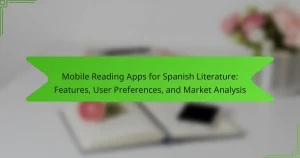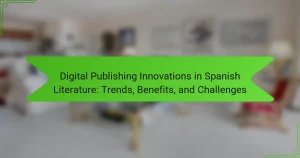E-books in Spanish literature enhance accessibility and reader engagement through various formats. Key formats include EPUB, PDF, MOBI, and HTML, each offering unique advantages. Accessibility varies by geographic and demographic factors, influenced by internet access and device ownership. Engaging readers effectively involves interactive features, targeted marketing, and multimedia elements that foster community discussions.
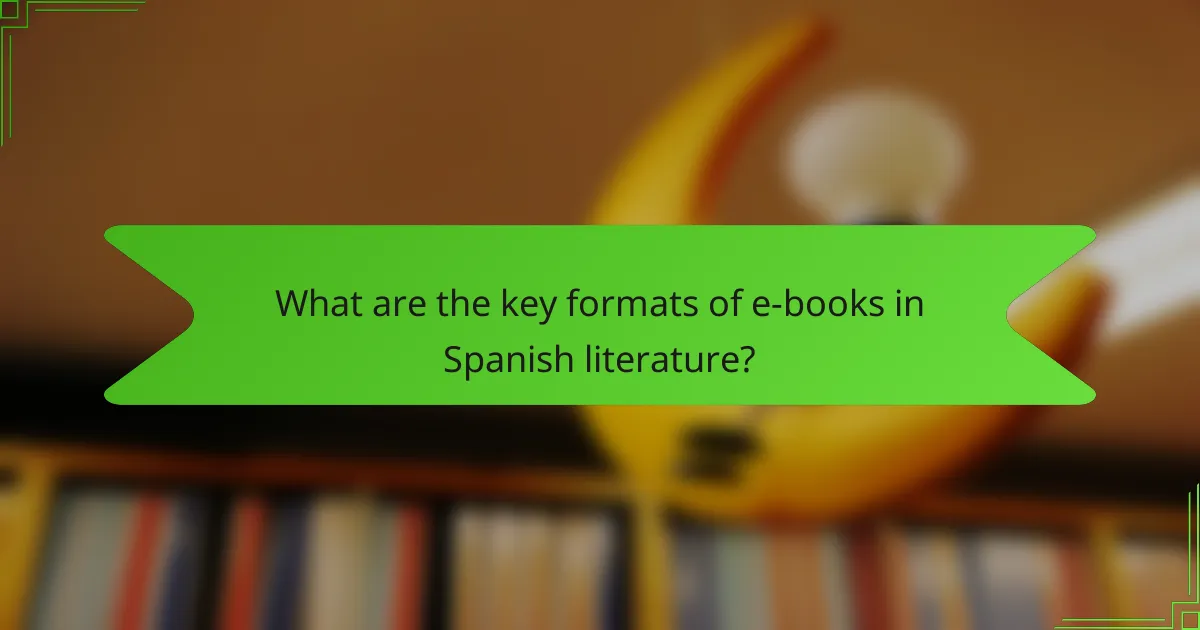
What are the key formats of e-books in Spanish literature?
The key formats of e-books in Spanish literature include EPUB, PDF, MOBI, and HTML. Each format offers distinct advantages for accessibility and reader engagement.
EPUB is widely used due to its reflowable text and compatibility with various devices. PDF maintains fixed formatting, ideal for academic texts. MOBI, primarily for Kindle devices, supports features like text-to-speech. HTML allows for interactive content, enhancing user experience.
These formats cater to diverse reading preferences, ensuring that Spanish literature remains accessible to a broader audience.
How do different formats impact reader experience?
Different formats significantly impact reader experience by influencing accessibility and engagement. E-books in Spanish literature, for instance, can vary in layout, interactivity, and multimedia integration. These differences affect how readers interact with the text, enhancing or detracting from their overall experience. E-books with dynamic features, such as audio narration or interactive elements, often lead to higher engagement compared to static formats. Accessibility features, like adjustable font sizes and background colours, also play a crucial role in accommodating diverse reader needs. Ultimately, the chosen format can either enrich the reading experience or create barriers, highlighting the importance of format selection in digital literature.
Which platforms are popular for accessing Spanish e-books?
Popular platforms for accessing Spanish e-books include Amazon Kindle, Google Play Books, and Apple Books. These platforms provide a wide range of Spanish literature in various genres and formats, enhancing accessibility for readers. Additionally, specialised sites like Scribd and Project Gutenberg offer extensive collections of Spanish e-books, often for free or through subscription services.
What are the advantages and disadvantages of various e-book formats?
E-book formats offer distinct advantages and disadvantages that impact accessibility and reader engagement in Spanish literature.
Advantages include compatibility with various devices, allowing readers to access content easily. Formats like EPUB and MOBI support features such as adjustable text sizes and embedded multimedia, enhancing the reading experience. Disadvantages involve potential formatting issues across different platforms, which can disrupt the reading flow. Furthermore, some formats may lack support for specific features, limiting reader engagement.
Overall, selecting the right e-book format is crucial for optimising accessibility and enhancing reader interaction with Spanish literature.
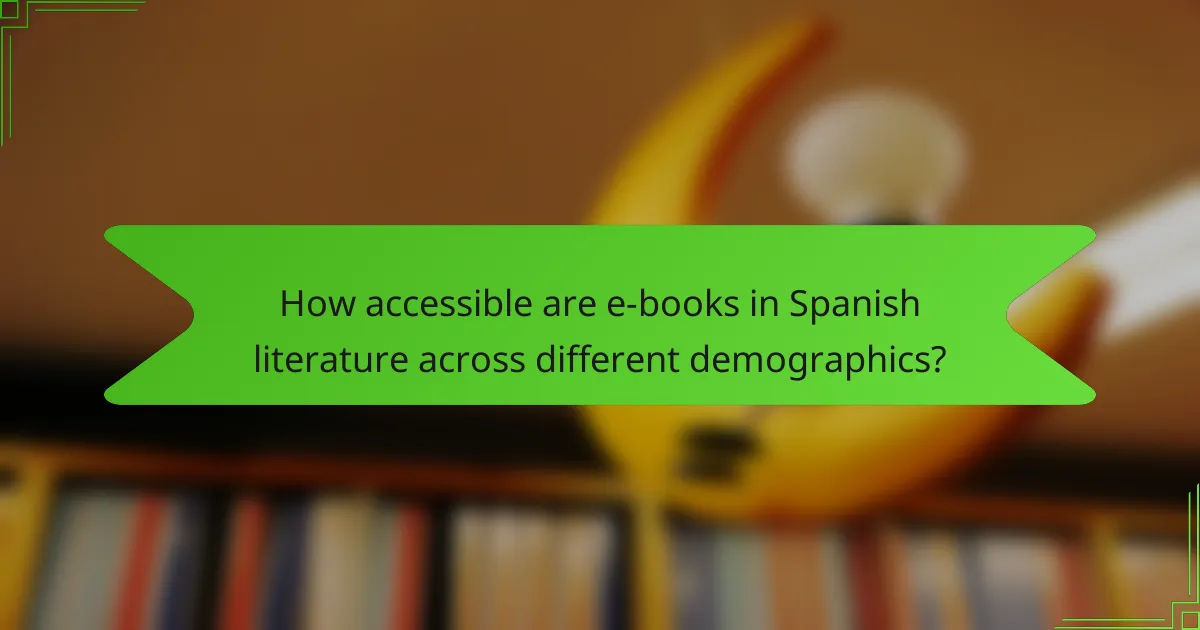
How accessible are e-books in Spanish literature across different demographics?
E-books in Spanish literature are increasingly accessible across various demographics, particularly due to digital platforms. Factors such as internet penetration, device ownership, and language proficiency influence accessibility.
For example, regions with higher internet access, like urban areas in Spain and Latin America, see greater engagement with e-books. Conversely, rural areas may face challenges due to limited connectivity. Additionally, younger generations are more likely to adopt e-books, while older demographics may prefer traditional formats.
Accessibility initiatives, such as public library e-book lending programs, further enhance reach among diverse populations. These efforts aim to bridge the gap for those with lower economic means or less familiarity with technology.
As a result, while e-books in Spanish literature are generally accessible, disparities exist based on geographic, economic, and age-related factors.
What challenges do readers face in accessing e-books?
Readers face several challenges accessing e-books, including digital literacy, device compatibility, and availability in Spanish. Many readers struggle with navigating e-book platforms or require specific devices for optimal access. Limited availability of Spanish literature in e-book formats further complicates access, as publishers may prioritise English titles. Additionally, copyright restrictions can limit the distribution of certain e-books, affecting reader engagement.
How do accessibility features enhance the reading experience?
Accessibility features significantly enhance the reading experience by providing tailored options for diverse reader needs. These features include text-to-speech, adjustable font sizes, and customisable background colours, which improve comprehension and engagement. For example, text-to-speech allows visually impaired readers to enjoy Spanish literature, while adjustable fonts cater to those with dyslexia. As a result, e-books become more inclusive, fostering a broader audience and enhancing overall reader satisfaction.
Which initiatives are improving e-book accessibility in Spanish-speaking regions?
Various initiatives are enhancing e-book accessibility in Spanish-speaking regions. These include the development of user-friendly platforms, partnerships with educational institutions, and the implementation of open-access policies.
For example, the “Biblioteca Digital Hispánica” offers free access to a vast collection of Spanish literature. Additionally, organisations like “Fundación Leer” promote digital literacy, ensuring readers can engage with e-books effectively. Efforts are also underway to create e-books that comply with accessibility standards, benefiting individuals with disabilities.

What strategies engage readers with Spanish e-books effectively?
Engaging readers with Spanish e-books effectively involves utilising interactive features, diverse formats, and targeted marketing strategies. Incorporating multimedia elements like audio and video enhances reader immersion. Offering multiple formats, such as PDFs and EPUBs, caters to varied preferences. Additionally, leveraging social media and online communities can boost visibility and foster discussions around the literature.
How do interactive features influence reader engagement?
Interactive features significantly enhance reader engagement in e-books. They create immersive experiences, allowing readers to interact with content through multimedia elements, quizzes, and annotations. These features cater to diverse learning styles, making literature more accessible and enjoyable. For instance, interactive maps and audio elements can deepen understanding of cultural contexts in Spanish literature. As a result, readers are more likely to retain information and develop a stronger connection to the material.
What role do social media and community platforms play in promoting e-books?
Social media and community platforms significantly enhance the promotion of e-books by fostering engagement and accessibility. These platforms allow authors to connect directly with readers, share insights, and build a loyal following. For example, targeted advertising on social media can reach specific demographics interested in Spanish literature. Community platforms enable discussions that deepen reader engagement, creating a vibrant ecosystem for e-book promotion. As a result, e-books gain visibility and traction in the competitive literary market.
Which marketing strategies are most effective for Spanish e-books?
Effective marketing strategies for Spanish e-books include targeted social media campaigns, influencer partnerships, and localised content. These approaches enhance visibility and engagement among Spanish-speaking readers. Utilising platforms like Facebook and Instagram can reach diverse audiences. Additionally, offering free samples or promotions can incentivise purchases, boosting overall sales.
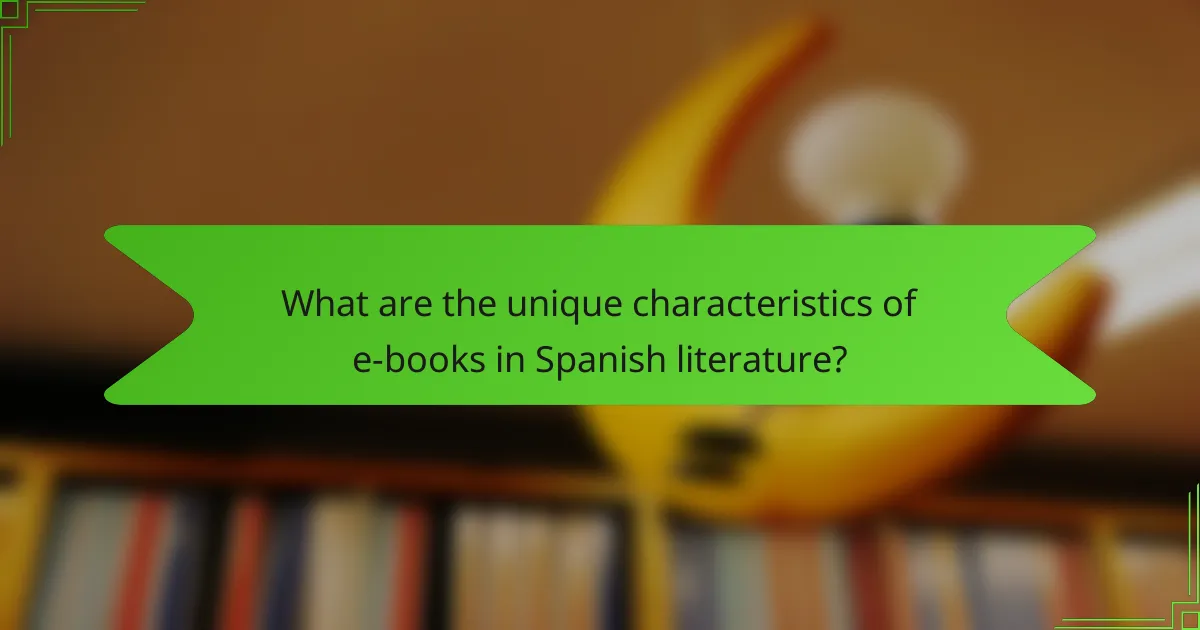
What are the unique characteristics of e-books in Spanish literature?
E-books in Spanish literature offer unique characteristics such as diverse formats, enhanced accessibility, and interactive reader engagement. These digital books include features like adjustable text size, audio options, and hyperlinks to supplementary content. Accessibility improves through platforms that support various devices and reading preferences. Reader engagement is heightened with interactive elements, such as embedded multimedia and social sharing options, which foster community discussions around literary works.
How do cultural themes shape the content of Spanish e-books?
Cultural themes significantly influence the content of Spanish e-books by shaping narratives and character development. Local traditions, historical events, and social issues often reflect in the storytelling. For instance, themes of identity and migration resonate deeply in contemporary works, appealing to readers’ experiences. Additionally, cultural references enhance engagement, making e-books relatable and immersive. This connection fosters a sense of community among readers, enriching the literary landscape.
What differentiates popular Spanish e-book authors from others?
Popular Spanish e-book authors stand out due to their unique storytelling styles, innovative formats, and strong reader engagement strategies. They often leverage interactive elements and multimedia to enhance the reading experience. Additionally, successful authors frequently utilise social media for direct communication with their audience, fostering a loyal fan base. Their ability to adapt to changing technology and reader preferences further differentiates them in the competitive e-book market.
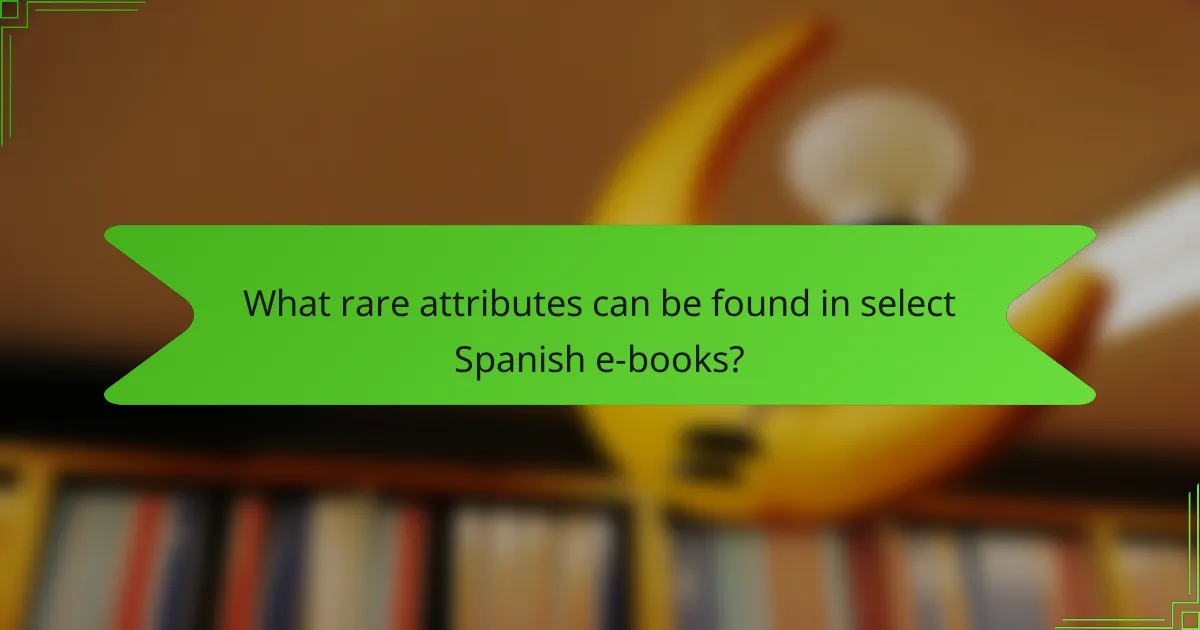
What rare attributes can be found in select Spanish e-books?
Rare attributes found in select Spanish e-books include interactive features, multilingual support, enhanced multimedia content, and unique author annotations. These attributes differentiate them from standard e-books, enhancing reader engagement and accessibility.
How do limited edition e-books cater to niche audiences?
Limited edition e-books cater to niche audiences by offering exclusive content and unique formats that enhance reader engagement. These editions often include special features such as author interviews, annotations, or interactive elements that appeal to specific literary interests. The scarcity of these e-books creates a sense of value and urgency among collectors and enthusiasts. Additionally, they are often marketed through targeted channels, ensuring they reach the right audience effectively.
What unique publishing models are emerging in the Spanish e-book market?
Innovative publishing models are transforming the Spanish e-book market. Subscription services are gaining traction, allowing readers to access a wide range of titles for a monthly fee. Additionally, self-publishing platforms are empowering authors, leading to a diverse array of voices and genres. Collaborative storytelling and interactive e-books are emerging, enhancing reader engagement through multimedia elements. These trends reflect a shift towards greater accessibility and personalised reading experiences in Spanish literature.
What are the implications of exclusive content for reader loyalty?
Exclusive content enhances reader loyalty by providing unique value and deepening engagement. Readers feel a stronger connection to e-books in Spanish literature when they access exclusive insights or narratives. This exclusivity fosters a sense of belonging and community among readers. As a result, they are more likely to return for future content, increasing overall reader retention.
What best practices should authors and publishers follow for e-books in Spanish literature?
Authors and publishers should ensure e-books in Spanish literature are accessible, engaging, and formatted correctly. Focus on user-friendly formats like EPUB and MOBI, which support various devices. Implement accessibility features such as text-to-speech and adjustable font sizes to cater to diverse readers. Engage audiences through interactive elements like hyperlinks and multimedia content, enhancing the reading experience. Regularly update e-books to reflect current trends and reader preferences, ensuring relevancy in the digital landscape.

